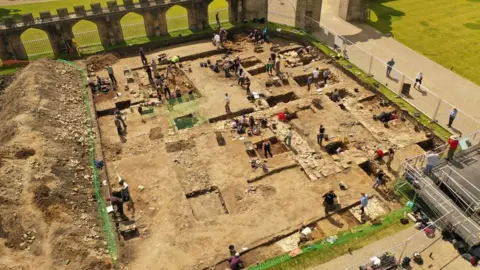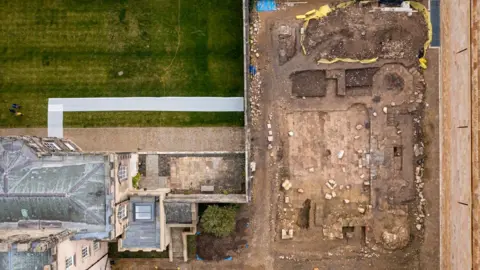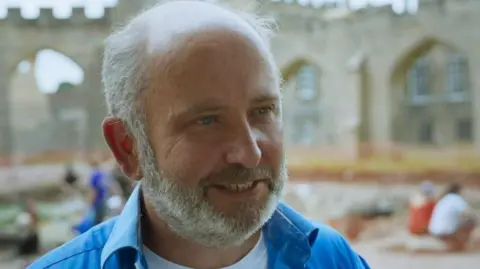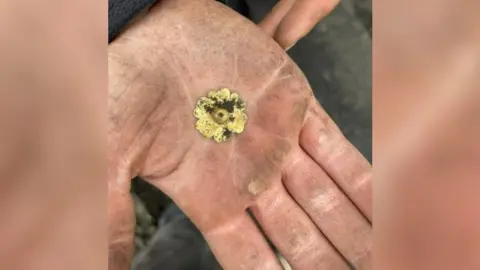Uncovered 1650s house captures 'a moment in time'
 Alexander Jansen/Durham University
Alexander Jansen/Durham UniversityA house which lay buried for almost 400 years reveals an insight into life in republican England, archaeologists say.
The mansion, at Auckland Castle, in Bishop Auckland, County Durham, dates back to about 1650 and was built by Sir Arthur Haselrig, who was a key ally of Lord Protector Oliver Cromwell.
But just 10 years later, the monarchy was restored and when the new Bishop of Durham John Cosin took over the castle, the house was demolished.
"It just sat there for 400 years without anybody having any real idea about the fact that it was there," the project's academic lead Prof Chris Gerrard said.
Archaeologists from Durham University and experts from charity The Auckland Project found the house during an excavation in June 2024.
Prof Gerrard said the ruins were about 4in (10cm) underneath the turf in most places.
Several medieval artefacts, including a gold flower decoration, a gold and silver knife, an arrowhead and a dice were also found in a separate trench on the castle's North Terrace.
 Alexander Jansen/Durham University
Alexander Jansen/Durham UniversityParliamentarian Sir Arthur was appointed governor of Newcastle in 1647.
He started acquiring land belonging to bishops, including Auckland Palace, which was one of the most important sites in the area, other than Durham Castle.
While building the house, he demolished a 13th Century chapel and reused the stones for his own mansion.
It was nearly completed, but in 1660 the monarchy was restored and Sir Arthur was imprisoned in the Tower of London, where he died.
 Megan Olshefski/Durham University
Megan Olshefski/Durham University"This house is just a moment in time when the world is turned upside down, everything changes, and he has the opportunity to acquire land for what he believes will be the new bright vision of republican England," Prof Gerrard said.
"His wish is to create something for his dynasty, for his descendants, but all that goes out the window when the regime changes again in 1660."
The house was later demolished and the stones were used to restore other medieval buildings on the site.
'Really exciting'
Prof Gerrard said the site offered "a real window" into that short period of time.
More than 100 people were involved in the digs, including Durham University students.
"When certain artefacts were found, like the gold, it just spread across the site and finding one yourself is really exciting," said second year archaeology student Annabelle Scullion.
"When you dig it up, you kind of think you are the first person to hold it in maybe hundreds of years."
 Megan Olshefski/Durham University
Megan Olshefski/Durham UniversityThe works attracted a lot of attention, with hundreds observing the archaeologists from a viewing platform over the summer.
Prof Gerrard said some people stayed for hours to watch the excavations - with the findings revealing a different side of the region's heritage from the pre-mining period.
"There's an element here of the local community today finding out something new about its own heritage and history, which I think they enjoyed and we enjoyed telling them about it," he said.
The team will return to the site for the last time in the summer, with works set to continue north of the palace.
"Auckland Palace will be, as far as we are concerned, one of the best understood bishop's palaces in Western Europe, from an archaeological point of view," said John Castling, archaeology curator at The Auckland Project.
It is hoped the artefacts will be displayed at a later stage.
Follow BBC North East on X, Facebook, Nextdoor and Instagram. Send your story ideas to [email protected].
